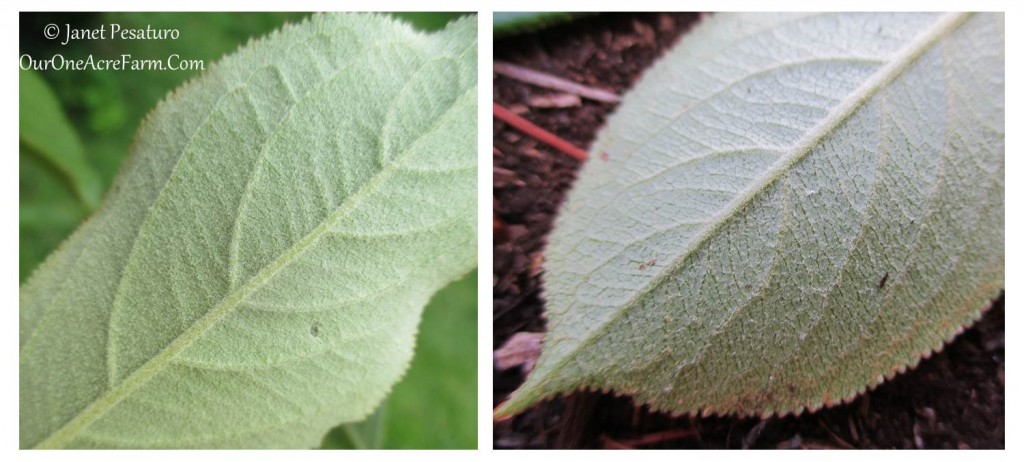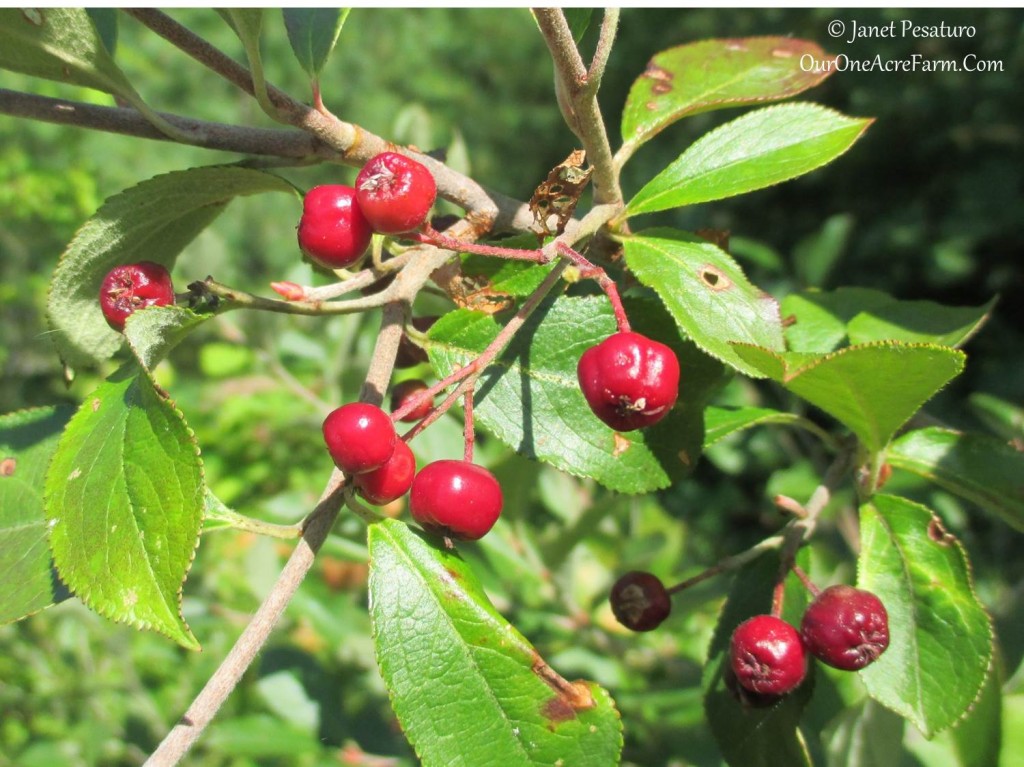Aronia berries are among the less well known edible wild plants. The common name is chokeBerry, but that leads to confusion with the better known chokeCHerry. Let’s face it – the Latin name is the way to go here, but in this case it is actually kind of nice. Don’t you think Aronia sounds pretty?
Aronia is a genus of 2 or 3 species of deciduous shrubs native to eastern North America. Black Aronia and red Aronia are distinct species. Purple Aronia is either a 3rd species, or a hybrid of the black and red species.
Caution: Do not eat any wild plant until you have confirmed its identity with several authoritative sources. I highly recommend consulting directly with an edible plants expert.
Health benefits of Aronia berries
Aronia berries are exceptionally high in anti-oxidant polyphenol compounds, which might help protect from cancer, and from diseases with an underlying inflammatory process. Some sources say that the darker Aronia berries are higher in polyphenols, but that is not necessarily true. A recent study showed black Aronia berries are indeed highest in one class of polyphenol compounds. But red and purple Aronia berries are better sources of other types of polyphenols.
- Black Aronia berries are highest anthocyanins.
- Red Aronia berries are highest in proanthocyanidins.
- Purple Aronia berries are highest in chlorogenic acids and quercetin glycosides.
The bottom line is that all three are high in anti-oxidant polyphenols, and may have similar health benefits. All are underutilized by humans, but becoming more popular. You can now purchase various Aronia berry products:
Range and habitat
Aronias prefer sandy soils of moist woods, swamps, and lakeshores. They fruit best with full sun exposure. The largest patch I know of in my area occurs along the edge of a beaver pond, where it fruits fairly well.
- Red chokeberry, Aronia arbutifolia (formerly Photonia pyrifolia), is native to eastern Canada, the eastern US seaboard states, and the southern states as far west as Texas, as you can see in the range map here.
- Black chokeberry, Aronia melanocarpa (formerly Photonia melanocarpa), is native to most of eastern North America except for FA, TX, and LA, as you can see here.
- Purple chokeberry, Aronia prunifolia, occurs where the ranges of black and red chokeberry overlap. Some people (myself included) think it is a hybrid of red and black chokeberry, rather than a distinct species.
Foraging Aronia Berries: Identification
Flowers
In spring (mid-late May, here in MA), Aronias bear clusters of small flowers. Each has 5 white, roundish petals, and about 20 pale pink to deep purple stamens (those tiny pink balls in the flowers in the photo). Recognizing the flowers can help you locate plants in spring. Remember where you saw the flowers, and return for the berries in late summer.
Leaves
The oval leaves with finely toothed edges can be up to about 3 inches long. They are arranged alternately on twigs. Examining the undersides of the leaves can help you determine species.
- Leaves of red Aronia have very wooly undersides, as you can see in the photo.
- Black Aronia leaves are said to smooth, or nearly so. If that is true, I don’t think I’ve seen pure black chokeBerry around here.
- Purple Aronia, whether it is a hybrid or a separate species, has leaves with somewhat wooly undersides. But based on the color and ripening time of the berries, I have identified purple chokeBerry which has leaves that are about as wooly as those of red chokeBerry.

The underside of red Aronia leaf on left, is very wooly. The leaf on the right, from a different location, is probably purple Aronia. Although the leaf underside is very wooly, it’s berries ripen a full month before those of the red Aronia on the left, and turn dark purple as they whither.
Berries
Black Aronias ripen earliest, red latest, and purple in between. Here, purple Aronia is ripe (deep reddish-purple) by mid-late August. Red Aronia ripens in mid-September. I don’t think I’ve ever seen pure black Aronia, but it is said to ripen earliest. The berries of all three types need to be harvested immediately when ripe, because they quickly dry up.
The flavor has been described as highly variable, from bitter to astringent to as sweet as blueberries. I’ve never had a chokeBerry that I’d describe as bitter, nor one that I’d describe as sweet as blueberries. To me, raw Aronia berries have a mild sweetness, an astringent (mouth-puckering) quality, and an unpleasant, styrofoam-like texture. I usually eat 1 or 2 raw berries while happening by, but have no desire to eat more than that. These are not the kind of berries you want to eat by the handful.
How to use Aronia berries
Aronia berreis are usually juiced. Sam Thayer says cold pressed Aronia juice is tart, but mild, with no bitterness. He adds that boiling them produces a less palatable juice, because it pulls some of the astringency from the pulp into the juice.
That said, the yield of juice from cold pressing must be quite low, because Aronia berries are not very juicy. If you have access to a large quantity, then go ahead and cold press. But because I don’t know of a prolific source of Aronia berries in my area, I may boil whatever I collect, and use it for jelly.

Deep magenta berries, with some (lower right) beginning to deepen to purple. I believe this is purple Aronia.
Sources
- Otakar, Rop. et al. 2010. Phenolic content, antioxidant capacity, radical oxygen species scavening and lipid peroxidation inhibiting activities of extracts of five black chokeberry (Aronia melanocarpa (Michx.) Elliot) cultivars. Journal of Medicinal Plants Research. 4(22), 2431-2437.
- Permaculture Plants: Aronia or Chokeberry
- Taheri, R., et al. 2013. Underutilized chokeberry (Aronia melanocarpa, Aronia arbutifolia, Aronia prunifolia) accessions are rich sources of anthocyanins, flavonoids, hydroxycinnamic acids, and proanthocyanidins. J. Agric. Food. Chem. 61(36), 8581-8588.
- Thayer, S. Nature’s Garden. 2010. Forager’s Harvest Press.
Shared On: Homestead Barn Hop, Thank Goodness it’s Monday, Natural Living Monday














I have never heard of aronia berries, thanks for sharing!
Thanks for stopping by, Heidi!
Wow! I have never heard of these. Probably because I am a desert rat and have always lived in the south west. Thanks for sharing a new plant friend on Natural Living Monday!
Thanks for stopping by, Amanda.
Pingback: 10 Shrubs for a Wildlife-Friendly, Edible Landscape - One Acre Farm
I have never heard of these berries. Thank you for sharing this information.
Glad you found it interesting, Karen.
we used to pick and eat these all the time and children. I really need to get some for my yard. do you know the difference between the (choke cherry) push and the (pin cherry) tree. fruit looks and tastes nearly the same but the tree is , well, a tree. Any idea where a person can buy some plants.
We have both chokeCHerry and pincherry. They both grow wild on our property (Canadian prairies).
The first is an ugly bush that can have thick but small trunks has clusters of dark berries in a tight clump (much like tight spaced grapes) that are extremely tart when ripe (dark purpley black…generally considered black). The leaves are somewhat rounded. The pincherries are on a delicate tree with longer leaves. The eye catching, jewel-red berries are much smaller and hang in very loose spaced clusters. The berries aren’t as tart. The first makes a dark purpley syrup/jelly, the latter makes a beautiful, clear red syrup/jelly.
Depending on your area, you can either dig them from the wild, go to a natural nursery to find native plants, or ask at a regular/specialty nursery if they are not native to your area.
Chokecherry is very invasive, pincherries, not as much.
I have always thought of the Black Chokeberry as the generic taste to a Chokecherry. Easier to grow with less disease however. I have both but still prefer Chokecherry for the best almond flavor and beautiful color jelly.
Pingback: All About Aronia: Grow Your Own Superfood Berries | Tenth Acre Farm